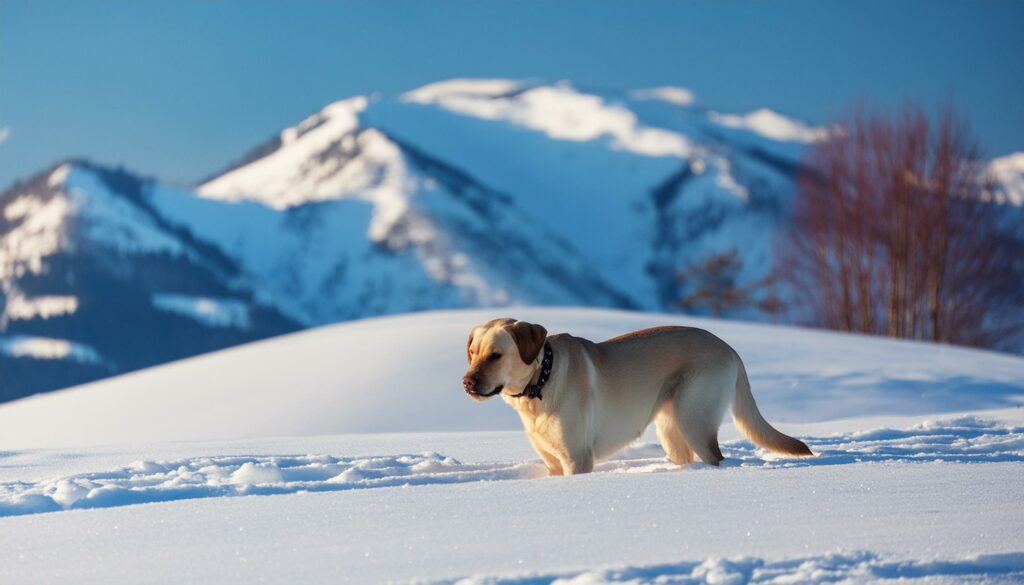The Labrador Retriever, a breed revered for its amiable nature and adaptability, thrives across various global locales. Despite their versatility, the question of their preference for hot or cold climates remains pivotal for pet owners aiming to provide optimal care. This article delves into whether Labradors prefer warmer or cooler environments and outlines effective strategies for maintaining their comfort through seasonal changes.
Understanding Labrador Retriever’s Natural Habitat
Labradors originated from the coastal regions of Newfoundland, Canada, where they were initially employed as fishermen’s helpers, retrieving nets and fish in the chilly North Atlantic. Their historical backdrop in a cold, moist climate suggests a breed well-adapted to lower temperatures. However, modern Labradors have spread globally, thriving in diverse climates, which speaks to their remarkable adaptability. This section examines how these origins have shaped the Labrador’s capabilities and preferences regarding temperature.
Physical Characteristics Affecting Temperature Preference
A Labrador’s physical makeup offers significant clues about its temperature preferences. Primarily, their double-layered coat, consisting of a dense undercoat and a water-resistant outer coat, serves as natural insulation. In winter, this feature helps them retain heat, while in summer, it aids in preventing overheating by keeping cool air near the skin during evaporation. Additionally, Labradors tend to have a robust body constitution that can generate and retain heat effectively but also allows them to withstand moderate heat without discomfort.
Labradors in Cold Environments

Labradors are often seen frolicking in snowy landscapes, seemingly impervious to the chill. Their thick coat provides substantial protection against cold, making them ideal companions for outdoor winter activities. However, despite their resilience, Labradors still require protection from extreme cold. Owners should be mindful of hypothermia risks in frigid temperatures, especially when the dogs are wet or if they are outside for prolonged periods.
Labradors in Warm Environments
Conversely, while Labradors can handle heat, they are not immune to the dangers of overheating. In warm climates, it is crucial to manage their exposure to heat carefully. Providing ample shade, water, and air-conditioned spaces can help mitigate the risk of heatstroke. During the hottest parts of the day, physical activities should be limited to protect these energetic dogs from overexertion.
Optimal Living Conditions for Labradors
Ideal living conditions for Labradors balance their ability to handle moderate temperatures with safeguards against extremes. Indoors, a comfortable setting would include temperature-controlled rooms where the air is neither too dry nor humid. Outdoors, they should have access to shaded areas and possibly a cooling vest or mat during hot weather, and a warm, insulated shelter during cold weather.
How to Keep a Labrador Comfortable in Cold Weather
To ensure a Labrador’s comfort during winter, consider additional warmth layers like coats or sweaters, especially for older dogs or those with health issues. Bedding should be warm and elevated off cold floors. Adjusting walks to the warmer parts of the day and ensuring they are dried off quickly after snow or rain are also critical.
How to Keep a Labrador Comfortable in Hot Weather
During summer, ensuring your Labrador stays cool is essential. Always provide access to fresh water and shade. Consider early morning or late evening walks to avoid peak heat times. Cooling body wraps, vests, or mats can significantly enhance comfort, as can a kiddie pool in the shade for them to splash around in.
Signs of Discomfort in Labradors Due to Temperature

Recognizing signs of discomfort from temperature extremes can help prevent serious health issues. Signs of heat stress include excessive panting, drooling, lethargy, and uncoordinated movement. In contrast, signs of cold stress may involve shivering, reluctance to keep moving, whining, or anxious behaviors.
The Role of Diet in Temperature Regulation
Diet also plays a role in how well a Labrador can regulate its body temperature. In colder months, they may require more calories to help maintain body heat, while in warmer months, a lighter diet can prevent excess weight gain, which adds to overheating risks. Hydration is crucial year-round but especially in hot weather to aid in temperature regulation.
Common Misconceptions About Labradors and Temperature
A common myth is that Labradors are entirely unaffected by cold due to their heritage. While they are better equipped than many breeds to handle the cold, they are not impervious to frostbite or hypothermia. Similarly, their tolerance to heat does not mean they can safely remain in hot cars or without shade and water for long periods.
Seasonal Care Tips for Labrador Owners
Seasonal care involves adapting your routine and your dog’s environment to meet the changing weather conditions. This includes more frequent grooming to manage shedding and skin health, checking for ticks in warm months, and ensuring paw protection from ice and heat.
The Impact of Climate on Labrador Health
Long-term exposure to inappropriate temperatures can lead to chronic health issues. In cold climates, arthritis and increased stiffness can occur, while in hot climates, Labradors may suffer from heat exhaustion or chronic dehydration.
Consulting with Veterinarians About Temperature Concerns
Regular veterinary check-ups can help catch any weather-related issues before they become severe. Discussing your Labrador’s living conditions and any concerns about how they handle temperature changes can lead to tailored advice that suits your pet’s health needs and lifestyle.
Conclusion
While Labradors are adaptable to both warm and cold climates, they do not have a definitive preference for one over the other. Their health and comfort depend significantly on the care and precautions taken by their owners. By understanding the breed’s needs and watching for signs of discomfort, you can ensure your Labrador enjoys a healthy, happy life regardless of the weather.
FAQs
Do Labradors need winter coats?
Yes, especially in extreme cold or for those with thinner coats, health issues, or advanced age.
How often should Labradors be hydrated in hot weather?
Provide constant access to fresh water, and monitor intake to ensure they stay hydrated.
What are the signs of heatstroke in Labradors?
Excessive panting, drooling, lethargy, and disorientation are key signs of heatstroke.
Can Labradors live outdoors in winter?
Labradors can spend time outdoors in winter, but should not live outside without proper shelter and warmth.
What are the best dietary adjustments for Labradors in summer?
Lighter meals more frequently can help prevent overheating and maintain energy levels.
